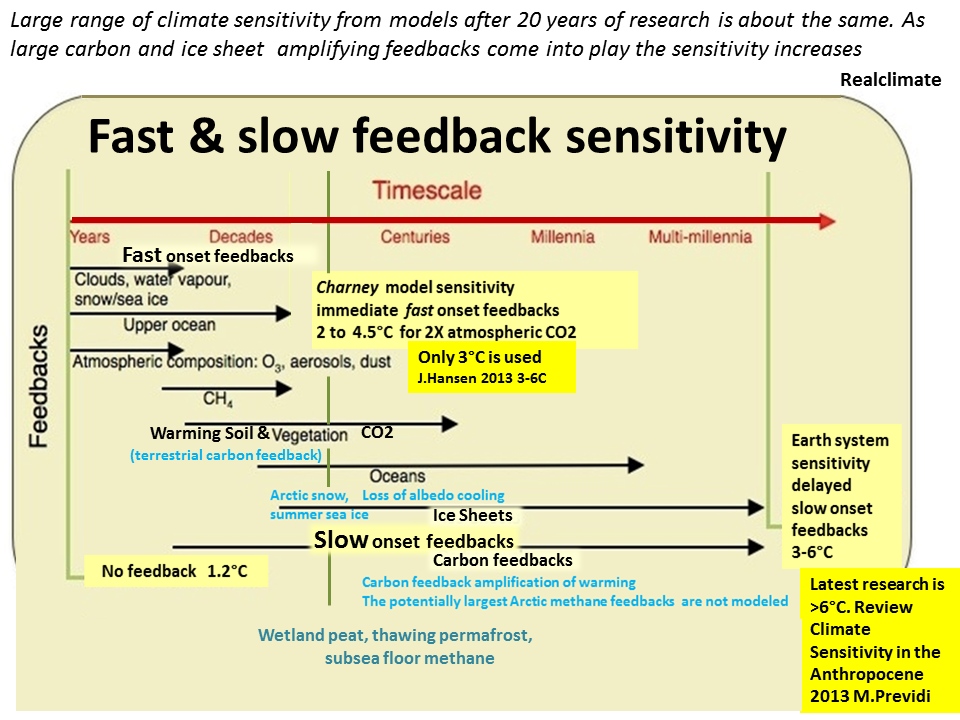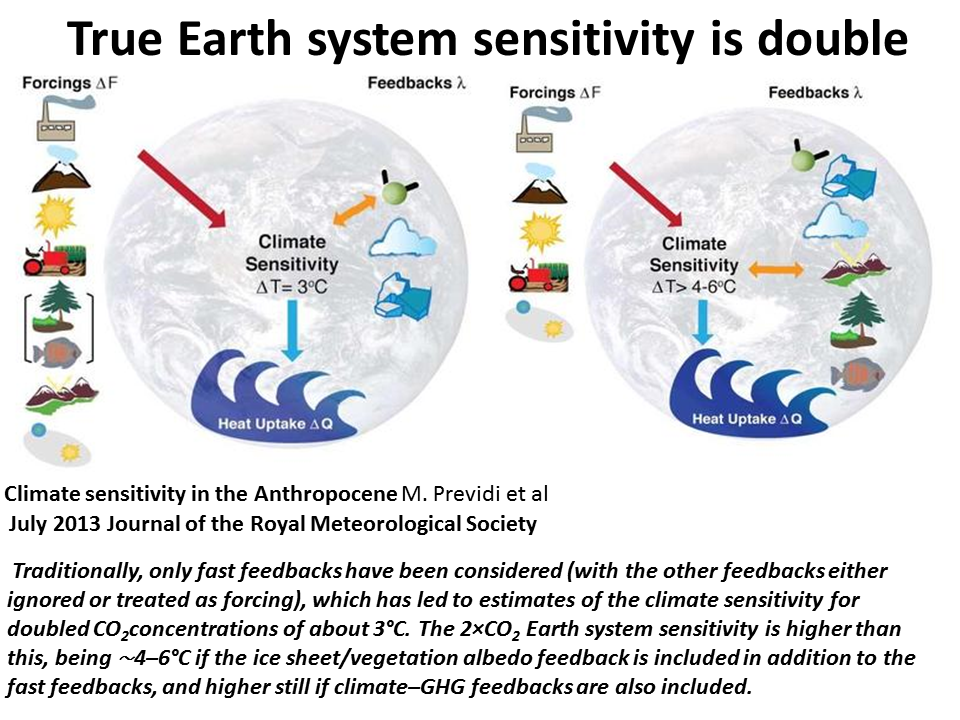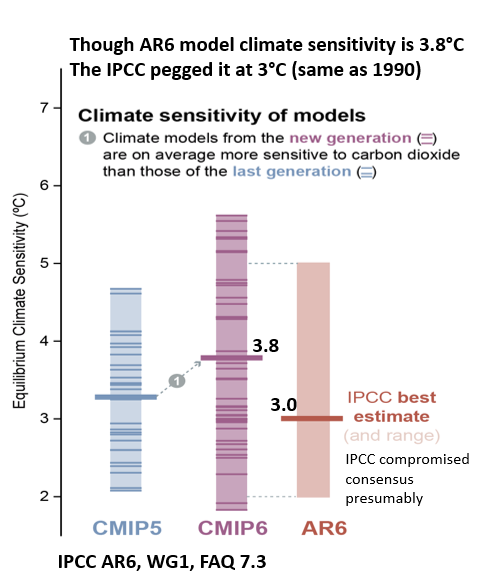Climate Sensitivity
The fast onset feedbacks are the ones that immediately act in response to an increase in atmospheric greenhouse gases (GHGs). They are mainly atmospheric feedbacks in the air, like water vapor, clouds and minute suspended particles (aerosols). Some albedo cooling effect of snow and ice is included.
Water vapor is actually the main GHG because it is so abundant but its global warming effect is mainly a feedback response. Warm air holds more water vapor and that about doubles the warming caused just by a GHG increase.
Slow onset feedbacks are planetary responses to global warming like melting ice sheets and thawing permafrost. Warming wetland peat is a slow feedbacks and melting sub seafloor methane hydrate is considered a very slow feedback.
The fast feedback sensitivity is taken to be 3C by the scientists and the slow feedback sensitivity is not used in the assessments- a huge error in underestimating the actual warming that will occur over the long term future.
It was James Hansen who pointed out in a 2008 paper that the true climate sensitivity for the very long term is (6°C), which is double the immediate fast feedback sensitivity (3C) that has been applied by the science since the first IPCC assessment in 1990.
It is the 'true' CS because it is protective of all future generations and life. The fast CS that does not include the large slow feedbacks is not protective. The slow FS is therefore by far the only policy relevant one.
Slow feedbacks take a long time (hence 'slow') in response to global warming, but they greatly increase over time and are irreversible. They are loss of albedo cooling from ice melting and Arctic carbon feedbacks from warming wetlands and thawing permafrost, that release methane and carbon dioxide.
There is little point in debating the precise number of the fast CS that is the only CS being used, when we are ignoring all important slow CS.
The debate is because the climate sensitivity fast feedback being used has a very large range, that has actually not changed significantly since 1990.
"The long term change in surface air temperature following a doubling of carbon dioxide (referred to as the climate sensitivity) is generally used as a benchmark to compare models. The range of results from model studies is 1.9 to 5.2°C... the models results do not justify altering the previously accepted range of 1.5 to 4.5°C. (IPCC WG 1 1990)
It is likely to be in the range 2°C to 4.5°C with a best estimate of about 3°C, (IPCC WG1 AR4 2007)"
The single fast feedback CS metric(3°C) as defined and applied by climate change science ignores the greatest global warming risk which is superheating hothouse Earth climate change mainly from large Arctic +ve (amplifying) slow feedbacks.
There are wide ranges of uncertainty for all aspects of climate change modeling (IPCC 2007), and there is a wide range of uncertainty for the fast climate sensitivity that determines the entire assessment of climate change.
"... climate sensitivity only considers the surface mean temperature and gives no indication of the occurrence of abrupt changes or extreme events. Despite its limitations, however, the climate sensitivity remains a useful concept.. IPCC AR4 2007 8.6.2.1 Definition of Climate Sensitivity"
The fact is climate sensitivity is not a linear constant factor (as is assumed in the science), it is dynamic increasing with time and temperature of warming. This is because of the many positive (bad) feedbacks that increase with warming.
Time-dependent climate sensitivity and the legacy of anthropogenic greenhouse gas emissions, Richard E. Zeebe, August 2013
Water vapor is actually the main GHG because it is so abundant but its global warming effect is mainly a feedback response. Warm air holds more water vapor and that about doubles the warming caused just by a GHG increase.
Slow onset feedbacks are planetary responses to global warming like melting ice sheets and thawing permafrost. Warming wetland peat is a slow feedbacks and melting sub seafloor methane hydrate is considered a very slow feedback.
The fast feedback sensitivity is taken to be 3C by the scientists and the slow feedback sensitivity is not used in the assessments- a huge error in underestimating the actual warming that will occur over the long term future.
It was James Hansen who pointed out in a 2008 paper that the true climate sensitivity for the very long term is (6°C), which is double the immediate fast feedback sensitivity (3C) that has been applied by the science since the first IPCC assessment in 1990.
It is the 'true' CS because it is protective of all future generations and life. The fast CS that does not include the large slow feedbacks is not protective. The slow FS is therefore by far the only policy relevant one.
Slow feedbacks take a long time (hence 'slow') in response to global warming, but they greatly increase over time and are irreversible. They are loss of albedo cooling from ice melting and Arctic carbon feedbacks from warming wetlands and thawing permafrost, that release methane and carbon dioxide.
There is little point in debating the precise number of the fast CS that is the only CS being used, when we are ignoring all important slow CS.
The debate is because the climate sensitivity fast feedback being used has a very large range, that has actually not changed significantly since 1990.
"The long term change in surface air temperature following a doubling of carbon dioxide (referred to as the climate sensitivity) is generally used as a benchmark to compare models. The range of results from model studies is 1.9 to 5.2°C... the models results do not justify altering the previously accepted range of 1.5 to 4.5°C. (IPCC WG 1 1990)
It is likely to be in the range 2°C to 4.5°C with a best estimate of about 3°C, (IPCC WG1 AR4 2007)"
The single fast feedback CS metric(3°C) as defined and applied by climate change science ignores the greatest global warming risk which is superheating hothouse Earth climate change mainly from large Arctic +ve (amplifying) slow feedbacks.
There are wide ranges of uncertainty for all aspects of climate change modeling (IPCC 2007), and there is a wide range of uncertainty for the fast climate sensitivity that determines the entire assessment of climate change.
"... climate sensitivity only considers the surface mean temperature and gives no indication of the occurrence of abrupt changes or extreme events. Despite its limitations, however, the climate sensitivity remains a useful concept.. IPCC AR4 2007 8.6.2.1 Definition of Climate Sensitivity"
The fact is climate sensitivity is not a linear constant factor (as is assumed in the science), it is dynamic increasing with time and temperature of warming. This is because of the many positive (bad) feedbacks that increase with warming.
Time-dependent climate sensitivity and the legacy of anthropogenic greenhouse gas emissions, Richard E. Zeebe, August 2013

Fast feedbacks
- water vapour,
- surface albedo
- clouds,
- aerosols


Climate Emergency Institute
NAP National Research Council 2011 Earth's deep paleo past shows a very high climate sensitivity - up to 7°C to 9.6°C in 3 million years ago (Pliocene).

July 2019
Most complete list.
Climate feedbacks in the Earth system and prospects for their evaluation
Climate feedbacks in the Earth system and prospects for their evaluation


The IPCC has always used only a mean for its single fixed sensitivity
For the IPCC AR6 the IPCC rejected the latest model results that put the sensitivity higher, and downgraded it to 3°C again.
2021 IPCC AR6 sensitivity models result is 3.8°C,
but IPCC improperly pegged it back at 3°C (same as 1990), rejecting risk in the entire assessment.
For the IPCC AR6 the IPCC rejected the latest model results that put the sensitivity higher, and downgraded it to 3°C again.
2021 IPCC AR6 sensitivity models result is 3.8°C,
but IPCC improperly pegged it back at 3°C (same as 1990), rejecting risk in the entire assessment.

Double click here to edit this text.
IPCC AR6 climate sensitivity
This single metric determines all IPCC
projections. There is no one number
that is the climate sensivity
Using only one number, ignores any possibility
of anything higher than this 3°C
There has always been a wide range of estimates
for the value, but the IPCC has only used a
single fixed metric (3°C)m which for long term
equilibrium warming runs contrary to climate
system science and to risk assessment.
Here is the big question for climate science .
If the climate change science, that policy makers rely on, turns about to be a large underestimate what happens to the future of the planet and of humanity?
The answer is runaway climate change (chaos) hot house Earth, because multiple enormous sources of amplifying are triggered. The big one is permafrost thaw, that is already releasing all three main GHGs -methane, CO2 and nitrous oxide. This is irreversible, and furthermore permafrost thaw become self-reinforcing. Thawing permafrost emits carbon by frozen microbes coming back to life and digesting organic material. This produces heat, which makes the thaw unstoppable and increasing.
The models that project the wide ranging sensitivity do not (still) include any any of these large feedbacks.
This the worst fundamental fatal flaw in climate change science- it's incredible.
The science has always agreed that higher climate sensitivity (than 3°C) is possible.
The 1st 1990 IPCC assessment piu it at 3°C , a range up to 4.5°C
If it is, all the global warming impacts will be earlier and larger (we are already finding this) than projected at 3°C. That risk must be excluded using a higher sensitivity. This was explained by in 2009 by economist Martin Weitzman his paper On modeling and interpreting catastrophic climate change. Catastrophic impacts were mentioned in IPCC 2021 TAR and 2007 AR4, but not since. The IPCC in effect has excluded catastrophic climate change impacts.
In addition, the sensitivity will increase with temperature, because of the many amplifying feedback responses to warming. As the planet surface warms large feedbacks come into play. which are all positive (amplifying) the global temperature increase. We already have methane and nitrous oxide that will increase with further warming, making the climate more sensitive. The IPCC excludes these from the projections by not adding extra feedback warming to climate sensitivity based on its warming projections. We know these feedbacks will happen and indeed they have started, but the IPCC acts as if they don't exist.
projections. There is no one number
that is the climate sensivity
Using only one number, ignores any possibility
of anything higher than this 3°C
There has always been a wide range of estimates
for the value, but the IPCC has only used a
single fixed metric (3°C)m which for long term
equilibrium warming runs contrary to climate
system science and to risk assessment.
Here is the big question for climate science .
If the climate change science, that policy makers rely on, turns about to be a large underestimate what happens to the future of the planet and of humanity?
The answer is runaway climate change (chaos) hot house Earth, because multiple enormous sources of amplifying are triggered. The big one is permafrost thaw, that is already releasing all three main GHGs -methane, CO2 and nitrous oxide. This is irreversible, and furthermore permafrost thaw become self-reinforcing. Thawing permafrost emits carbon by frozen microbes coming back to life and digesting organic material. This produces heat, which makes the thaw unstoppable and increasing.
The models that project the wide ranging sensitivity do not (still) include any any of these large feedbacks.
This the worst fundamental fatal flaw in climate change science- it's incredible.
The science has always agreed that higher climate sensitivity (than 3°C) is possible.
The 1st 1990 IPCC assessment piu it at 3°C , a range up to 4.5°C
If it is, all the global warming impacts will be earlier and larger (we are already finding this) than projected at 3°C. That risk must be excluded using a higher sensitivity. This was explained by in 2009 by economist Martin Weitzman his paper On modeling and interpreting catastrophic climate change. Catastrophic impacts were mentioned in IPCC 2021 TAR and 2007 AR4, but not since. The IPCC in effect has excluded catastrophic climate change impacts.
In addition, the sensitivity will increase with temperature, because of the many amplifying feedback responses to warming. As the planet surface warms large feedbacks come into play. which are all positive (amplifying) the global temperature increase. We already have methane and nitrous oxide that will increase with further warming, making the climate more sensitive. The IPCC excludes these from the projections by not adding extra feedback warming to climate sensitivity based on its warming projections. We know these feedbacks will happen and indeed they have started, but the IPCC acts as if they don't exist.
Climate sensitivity in the Anthropocene, M Previdi et al, 2011
Evidence from Earth's history suggests that slower surface albedo feedbacks due to vegetation change and melting of Greenland and Antarctica can come into play on the timescales of interest to humans, which could increase the sensitivity to significantly higher values, as much as 6 °C.
Even higher sensitivity may result as present-day land and ocean carbon sinks begin to lose their ability to sequester anthropogenic CO2 in the coming decades. The evolving view of climate sensitivity in the Anthropocene is therefore one in which a wider array of Earth system feedbacks are recognized as important. Since these feedbacks are overwhelmingly positive, the sensitivity is likely to be higher than has traditionally been assumed.
Even higher sensitivity may result as present-day land and ocean carbon sinks begin to lose their ability to sequester anthropogenic CO2 in the coming decades. The evolving view of climate sensitivity in the Anthropocene is therefore one in which a wider array of Earth system feedbacks are recognized as important. Since these feedbacks are overwhelmingly positive, the sensitivity is likely to be higher than has traditionally been assumed.
Fast and slow feedbacks
There are slow responding and fast responding feedbacks.
The 3°C climate sensitivity metric is based only on fast feedbacks

Climate sensitivity is the fundamental (single fixed) metric determining all projections in the IPCC assessments.
It is defined as the equilibrium warming resulting from a doubling of atmospheric CO2.
There has always been a very large range from the models used.
The IPCC just takes (only) the middle of the range. It has been 3°C since the fits 1990 IPCC Assessment.
It is defined as the equilibrium warming resulting from a doubling of atmospheric CO2.
There has always been a very large range from the models used.
The IPCC just takes (only) the middle of the range. It has been 3°C since the fits 1990 IPCC Assessment.
Video 2011, AGU panel presentation
Paleoclimate record points toward potential rapid climate change
There is no one number that is climate sensitivity
Paleoclimate record points toward potential rapid climate change
There is no one number that is climate sensitivity
Dou
ble click here to edit this text.
ble click here to edit this text.
Permafrost emitting carbon is what the science has called a slow Feedback
Nonlinear climate sensitivity and its implications for future greenhouse warming
Th research finds that on a worst-case emissions scenario within the 21st century, global mean temperatures will very likely exceed maximum levels reconstructed for the last 784,000 years.
Th research finds that on a worst-case emissions scenario within the 21st century, global mean temperatures will very likely exceed maximum levels reconstructed for the last 784,000 years.